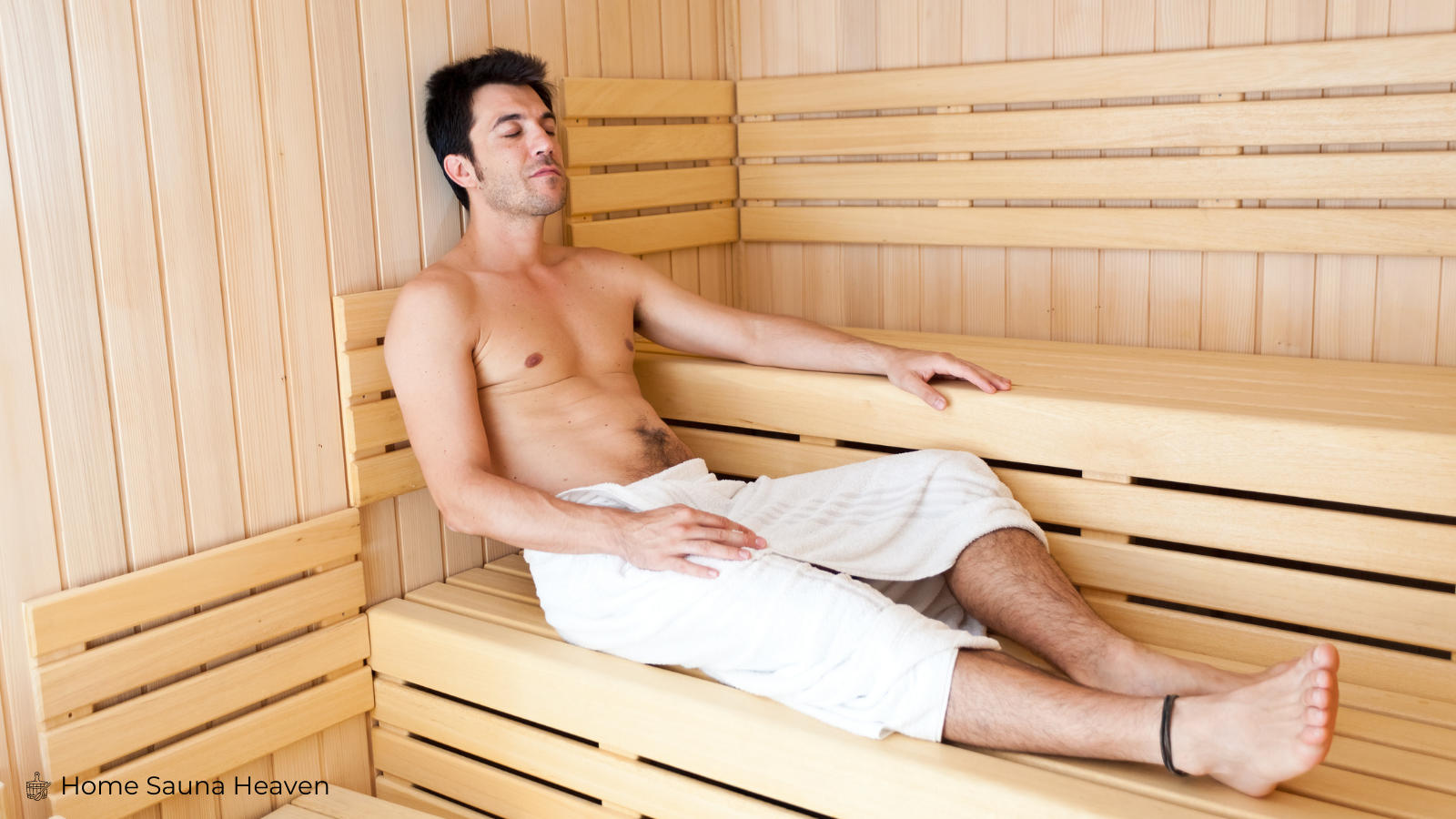
A traditional sauna is a wooden cabin that people sit in to relax and experience an intensely hot environment. Traditional saunas generate heat using an electrical or wood-burning stove that heats a stack of sauna stones. Some people ladle water on these stones to create steam. Below we’ll take you through everything you need to know about what is a traditional sauna?
TRADITIONAL SAUNA EXPLAINED
Traditional saunas have been around for thousands of years. They are enjoyed around the world for their relaxation, social, and potential health benefits. But, what is a traditional sauna? And, how do they work? What’s the difference between a traditional sauna and an infrared sauna? Check out our guide to traditional sauna – we’ll take you through everything you need to know about traditional sauna.

JUMP MENU
How They Work | What Are The Benefits? | How Hot Are They? | How Often Should You Use? | Are They Safe? | Traditional vs Infrared Sauna?
HOW DOES A TRADITIONAL SAUNA WORK?
The modern concept of a traditional sauna originated in Finland. These saunas were historically heated using a wood-burning stove. Sauna stones were placed over the wood burner and these stones would then heat the air inside the sauna cabin.

Nowadays, most traditional saunas are electrically powered. They follow the same concept as a wood-burning stove but use an electrical heater to heat a stack of sauna stones. The stones become super hot and they, in turn, heat the air inside the sauna cabin.
The two key aspects of a traditional sauna are heat and steam. Both can be controlled and adjusted to deliver the perfect session for the sauna user. The heat level is controlled by adjusting the temperature setting on the sauna heater. This can be adjusted higher or lower depending on the individual’s preference.
Humidity is an optional component. Some people prefer to relax in a hot dry sauna. Others like to generate steam to give a short sharp burst of intense heat. To generate humidity all you have to do is pour some water across the hot rocks. The level of humidity is controlled by adding more or less water during the session.
WHAT ARE THE BENEFITS?
The key benefits of traditional sauna are relaxation and stress relief, mental health improvement, socialization, and sleep improvement. These are the top benefits reported by a global survey of over 2,000 users. The full list of advantages of sauna is extensive and includes many potential health benefits.

Most people enjoy spending time in a traditional sauna for its social benefits – meeting and chatting with other sauna users. And, for its ability to deeply relax and calm the mind. It is a very popular tool for relieving stress and unwinding after a long hard day. For more on the benefits of traditional sauna, check out the Pros and Cons of Traditional Sauna.
HOW HOT DOES A SAUNA GET?
Traditional saunas are incredibly hot environments. But, how hot does a traditional sauna get? Traditional saunas typically operate in the region of 160-175°F (71-79°C). And, they can get as hot as 190°F (88°C). For more see – Best Temperature for a Traditional Sauna.

If you haven’t experienced this level of heat before it may take some time to get used to. While many people find it deeply relaxing to spend time immersing themselves in this level of heat – beginners might struggle.
Experienced traditional saunas users can spend anywhere between 5-30 minutes in a sauna per session. However, if you are a beginner you should aim to start at the lower end of this time frame and gently work your way up if you feel comfortable doing so. Never stay in longer than feels comfortable.
HOW OFTEN TO SAUNA?
How often should you sauna? The frequency at which you jump in the sauna will depend on how you feel and how your body adapts to the intense heat. Many experienced users like to sauna three times per week. That’s working out at about every other day. Our advice is to start low and slowly increase the frequency if you feel comfortable doing so. Once per week is a good starting point for a beginner.

ARE THEY SAFE?

How to stay safe in a traditional sauna. Traditional sauna is safe for the majority of people. However, if you have never used a sauna before, are pregnant, or have any underlying health conditions you should seek medical advice before using a sauna. People who suffer from heat intolerance, have a heart condition, or suffer from high blood pressure may be advised to avoid using a sauna.
RELATED
TRADITIONAL SAUNA VERSUS INFRARED SAUNA
What’s the difference between a traditional sauna and an infrared sauna? Well, it comes down to the way they generate heat and how they heat the body. As discussed above, a traditional sauna uses a wood-burning stove or an electrical heater to heat a stack of sauna stones.

And, in turn, these hot stones heat the air inside the sauna. The hot air then heats your body. This process requires a lot of heat and traditional saunas run at much higher temperatures compared to infrared saunas.
An infrared sauna heats the body directly without heating the air inside the sauna. It is a more direct approach and allows an infrared sauna to run at lower temperatures. An infrared sauna typically operates at 120°F (49°C) compared to 190°F (88°C) of a traditional sauna.
Infrared saunas create heat using infrared light. Special ceramic and carbon fiber heat panels are placed in the interior walls of an infrared sauna. These heat panels emit infrared light that is invisible to the human eye. It travels from the heating source until it strikes and begins to heat your body.
WHERE DID TRADITIONAL SAUNA COME FROM?
When people talk about traditional sauna they are generally referring to modern Finnish sauna. And, sauna is a national pass time in Finland. Its people love to relax in a sauna more than any other people around the globe.

However, the history of sauna is more complex. It looks like sauna originated independently in many different regions of the words over thousands of years. For more see our full guide to the origins of sauna.
WHAT IS A TRADITIONAL SAUNA FAQ

WHAT’S THE BEST TEMPERATURE FOR A TRADITIONAL SAUNA?
The best temperature for a traditional sauna is 160-175°F (71-79°C). If you want to experience deep relaxation, aim for this temperature range.
WHAT HEATS A TRADITIONAL SAUNA?
A traditional sauna is heated using either a wood-burning stove or an electrical heater. This heats a stack of sauna stones that in turn heats the air inside the sauna cabin to 190°F (88°C).
WHAT DO YOU WEAR IN A TRADITIONAL SAUNA?
You should wear loose-fitting, breathable, comfortable clothes in a sauna. Swimwear is a good choice. This means, a bathing suit for women or swimming trunks for a man. Some people like to wrap a towel around their chest or waist to soak up sweat. For more see what to wear in a sauna.
DOES A TRADITIONAL SAUNA BURN CALORIES?
No, a traditional sauna does not burn calories. It will cause you to sweat profusely which will result in a temporary reduction in water weight. But, this water must be replaced as soon as possible to prevent dehydration.
WHAT SHOULD YOU NOT DO IN A TRADITIONAL SAUNA?
You should not drink alcohol, use your phone, or stay in longer than you feel comfortable in a traditional sauna. For more advice see our guide – proper sauna etiquette.
SHOULD YOU DRINK WATER IN A TRADITIONAL SAUNA?
Yes, you should drink water in a traditional sauna. All water lost to sweat must be replaced to avoid the effects of dehydration. You should drink three pints of water before, during, and after your sauna session to remain safely hydrated.
About the Author
MAGNUS KARLSSON (BSc, MSc)
• Senior Editor at Home Sauna Heaven
As a native Swede, Magnus developed a deep fascination with the art of sauna bathing from an early age. Born and raised in the picturesque landscapes of Småland Sweden, he grew up in a family where sauna was deeply embedded in the community and daily routine. He graduated from Linnaeus University with a Master of Science in Health Science with a special focus on the “Comparative Analysis of Traditional Saunas vs. Infrared Saunas”.
Moving to the United States in his late twenties, Magnus worked as a health and fitness advisor in a well-known spa and wellness retreat in Malibu California. Over the next 12 years he became the spa’s leading sauna consultant and mentored colleagues on the benefits and applications of sauna therapy.
In 2019 he relocated to Florida to open his own wellness retreat in the Tampa Bay area. Here he continues to inspire others with the restorative power of sauna therapy. In 2020, he became senior editor of Home Sauna Heaven where he shares his deep understanding of infrared sauna and offers expert advice on its applications, benefits, and periodic product reviews.
